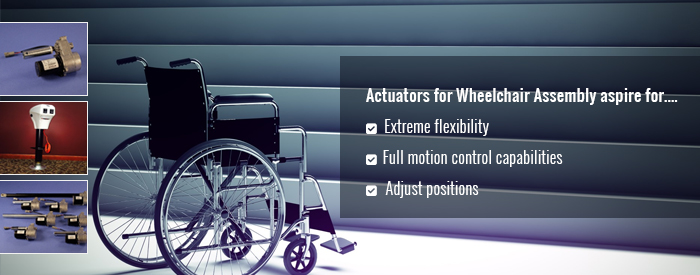Gone are the days wherein wheel chairs required an external support to manage the movements. Nowadays, the wheelchair user can himself control the chair all by himself, and adjust positions to suit his requirements. This is all possible due to the revolutionary invention of linear actuators that provide extreme flexibility to the user. With the actuator integrated wheelchair system, you won’t get tired sitting in the same position for a long time. Instead, you have options for raising, lowering, and reclining the seat, thereby giving the user with full motion control capabilities. This post discusses why wheel chairs driven by electric linear actuators are gaining popularity.
4 Reasons that Substantiate the Use of Linear Actuators in Wheel Chairs
Owing to the impeccable performance capabilities, electric linear actuators are largely replacing pneumatic and hydraulic actuators in wheelchair assembly and other medical applications. Some medical devices powered by these actuators, include including operating room beds, dentist chairs, diagnostic systems (X-ray machines, MRI and CT scanners), and so on. What accounts for the immense popularity of these medical actuators? Read below to know more
- Medical grade devices/equipment must always be cleaned and hygiene. This is applicable to wheel chairs as well. Linear actuators can operate without any fluid or ancillary equipment. This ensures clean operation. Additionally, they can be subjected to frequent heavy wash downs using detergents. Also, they are compatible with other sterilization processes.
- Linear actuators can be manufactured to withstand heavy loads. They can also be fabricated to be compact for reducing the overall size of the application. They ensure reliable results owing to their powerful performance, clean operation, and increased efficiency.
- They can be made combining motor and actuator and also power controls, offering diverse integration capabilities. This not only helps reducing the spacing requirements but also enhancing their mobility and control features.
- Electric actuators combine force, velocity, and positioning in a compact motion control device, making them a popular choice for motion control in critical, life-saving medical applications. They can also be customized to precise stroke lengths, clevis end-tips, control wires, cable lengths, different gearing ratios and much more.
With a right combination of precision, reliability, durability and ergonomics, they offer several advantages that suit several industries, and most importantly the medical industry.

